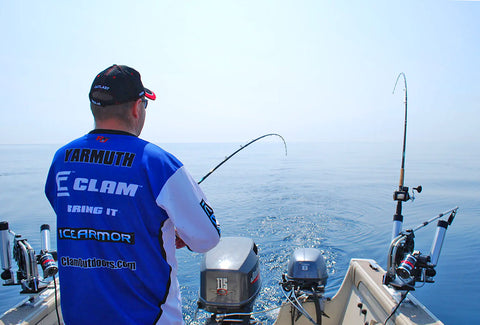Six of the nation’s top ten safest boating states border the Great Lakes. According to the Bureau of Transportation Statistics, Minnesota is the safest state for recreational boating, where in the most recent study there were 9.40 boating accidents per 100,000 registered watercraft in the state. Nevada is the least safe state for boating according to the study, which found 129.49 accidents per 100,000 registered watercraft. That’s quite a jump.

Safety-conscious Great Lakes charter captain Lance Valentine wears a flotation suit when fishing the frigid spring waters of the Detroit River and required his angels to don a PFD when aboard. Note one of several fire extinguishers he keeps handy aboard his 20 foot boat.
As we wrap up the traditional boating season on the Great Lakes, it pays to reflect on our own experiences or close calls—and those of others—as they relate to how we might do things different next season to ensure it will be a safe one for boating and fishing.
In my own case, I’m purchasing and installing a cargo net for the underside of my center console’s T-Top. There I will place a PFD for each passenger and a throwable seat cushion device, as required by law. My wife actually isolated the issue when she asked for a PFD one rough day while approaching a tricky harbor entrance that had her concerned. When it took me a minute to locate and wrest her vest from the bow locker she asked if there were a place aboard to keep floatation devices handier and accessible in the case of an emergency. I read her signals loud and clear, agreed and the T-top bag should solve the issue.

When fishing solo, the author uses an Autotether Wireless Engine Cut-off and Man Overboard Alert System. (autotether.com)
I received a clinic on the importance of boat safety gear and accessibility recently when enjoying a spring walleye charter trip with Capt Lance Valentine. Capt Valentine starts his season each April on the busy waters of the Detroit River, where-ocean going freighters, fellow anglers, recreational boaters and frigid, fast-paced currents conspire to make the river a particularly dangerous place for ill-prepared boaters.

It may not be pretty but this DIY boarding ladder will be appreciated the next time someone falls over the side this Great Lakes fishing boat. It’s important that watercraft be equipped with ladders that allow a boater to re-board from the water without assistance. (westmarine.com; garelick.com)
The Flint, Michigan, native exercises a vertical jigging method that slays walleyes wherever they frequent heavy current, a tactic he refined while fishing the Detroit River and has proven deadly on other walleye-rich waters like the St Marys, Mississippi and Missouri rivers. And he does so not from a traditional size, inboard-powered charter vessel large enough for “six pack” charters, but from 20 foot, outboard pushed, dual-console boat.
BOAT SAFETY RANKED BY STATE
The nation’s top 10 most accident-prone boating states, none of which share any Great Lakes coastline, based on accidents causing injury, death or property damage per 100,000 registered watercraft, are:
- Nevada – 129.49
- Utah – 126.15
- Arizona – 104.69
- New Jersey – 77.35
- New Mexico – 73.83
- Maryland – 71.61
- Rhode Island – 66.28
- Florida – 65.61
- Hawaii – 64.67
- Massachusetts – 58.14
The nation’s top 10 safest boating states are:
- Minnesota – 9.40*
- Iowa – 13.40
- Michigan – 14.96*
- Wisconsin – 17.24*
- Oklahoma – 18.14
- Indiana – 20.35*
- South Dakota – 20.37
- Pennsylvania – 20.54*
- North Dakota – 20.72
- Vermont – 20.91
*Great Lakes state
From the moment they board his boat, Valentine’s customers are schooled on safety, what he expects of them—and vice versa—and shown what and where every safety device is located on the boat. For the balance of the fishing trip, while patiently teaching the jigging tactic that often requires the angler to stand to execute, Valentine is weaving safety lessons into the stories he shares about his experiences charter captain.

Underfoot aboard Valentine’s boat are lockers labeled in bright letters noting what safety gear is where, leaving no doubt where to grab what in the event that things go south.
One of the most important safety lessons Valentine preaches is accessibility. As I discovered when asked to locate my wife’s PFD, just because you have the required gear aboard—somewhere—doesn’t mean you are prepared for an emergency, let alone in compliance with the law. For example, Ohio laws states that “each PFD shall be readily accessible to each person aboard the watercraft at all times.” Don’t be surprised if, during a routine safety check by watercraft officers, you get cited if you have to do more than lift a hatch to expose the proper PFDs. Ditto required fire extinguishers and emergency signaling devices, and for good reason.

Labeling the location and contents of safety gear aboard goes a long way when seconds matter during an emergency.
Another often overlooked safety issue is the ability to re-board a boat from the water in the event of a man overboard situation. Builders of bass-style boats in recent years have been required to include a boarding ladder or device that allows a lone boater to get back aboard without assistance. A look at many fishing craft on the Great Lakes will reveal some that would present a challenge to re-board without considerable assistance.
As with your fishing tackle, the off-season is a good time to evaluate the safety of your watercraft and inspect, update and/or relocate the equipment that might mean the difference between a good day on the water or a tragic one. And the winter boat shows that approach with the New Year are great places to see, learn about, and purchase new safety gear. And perhaps catch one of Lance’s walleye-fishing seminars to boot!







